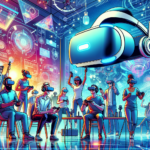Pimax Crystal Light Tracking Enhanced with Latest Software Update
Pimax has introduced a new iteration of its Pimax Play software tailored for the Crystal Light VR headsets, with the goal of enhancing Pimax Crystal Light Tracking in difficult environments. This update, designated as version 1.38.02.01, concentrates on improving stability in areas featuring minimal textures, expansive spaces, and rooms with windows. Moreover, it optimizes tracking during specific actions, such as aiming and circular movements with controllers. These enhancements aim to deliver a smoother and more engaging VR experience for users, underscoring the importance of accurate Crystal Light Tracking in bolstering overall user satisfaction.
Enhanced Tracking Features
The recent software update incorporates several significant improvements aimed at augmenting the tracking capabilities of the Pimax Crystal Light headset:
- Advanced Environment Handling: The update guarantees enhanced stability and precision in settings that have historically posed challenges for VR tracking, such as locations with sparse textures or open areas. This enhancement contributes to precise tracking even in intricate environments, enriching the overall VR experience.
- Movement Stability: The optimization of tracking during particular actions, such as shooting or executing circular motions with controllers, has been improved. This modification minimizes lag or jitter, allowing users to interact more seamlessly with virtual settings.
Customization and Efficiency
In addition to the advancements in tracking, the update unveils several functions aimed at refining user experience and effectiveness:
- Customizable Headset Screen Timeout: Users can now modify the timing for when the headset display goes dark, providing greater control over power management. This option lets users balance usage with battery preservation, ensuring availability when needed while conserving energy.
- Optimized Resource Usage: The software minimizes computational resource demands, enhancing performance and reducing system burden. This allows users to enjoy VR experiences without noticeable drops in system performance, creating a more fluid interaction with virtual environments.
- Enhanced Onboarding Experience: Pimax has also revamped its onboarding guide to facilitate a smoother setup process for new users of the Crystal Light headset. This streamlined approach helps users quickly dive into the VR content without facing unnecessary obstacles.
Graphics Card Compatibility
The latest update also addresses compatibility challenges associated with new graphics cards, ensuring that the Pimax Crystal Light remains compatible with the latest technology:
- Nvidia RTX 50 Series Compatibility: The Nvidia RTX 50 series is widely compatible with Pimax headsets, though users might experience slight micro-stutters during vertical synchronization. Ongoing driver updates from Nvidia are expected to mitigate this issue.
- AMD 9070 and 9070 XT Cards: Those equipped with these AMD cards may face some compatibility challenges. Pimax recommends temporary solutions, such as operating the Crystal Light at 120Hz or disabling specific Windows settings to enhance performance at 90Hz.
Future Developments – Crystal Super Headset
In addition to the updates for Crystal Light, Pimax is preparing for the launch of its new **Crystal Super headset**. This upcoming device features advanced specifications, including higher resolution choices and a broader field of vision. The Crystal Super permits users to swap optical systems, offering flexibility between Micro-OLED or 50 PPD QLED displays.
User Impressions and Reviews
Early evaluations of the **Crystal Super** from the MRTV XR Hardware Showcase have been favorable, emphasizing its sharp visuals and vivid colors. These insights suggest that Pimax is innovating within the realms of VR clarity and performance, which could greatly benefit users across various sectors.
Additional Insights
As VR technology continuously progresses, updates like this one are essential in enhancing user experiences. The emphasis on bolstering tracking stability, specifically Pimax Crystal Light Tracking, will be advantageous for applications in gaming, professional simulation software, and much more. Furthermore, improved compatibility with recent graphics cards ensures that Pimax headsets maintain competitiveness and remain viable choices for casual gamers and devoted VR enthusiasts alike.
Frequently Asked Questions
Q: How has the latest Pimax Play software update improved tracking stability for Crystal Light headsets?
A: The update boosts stability in challenging environments, such as those with sparse textures or open areas, and refines tracking during specific movements like aiming and controller actions.
Q: What is the impact of the update on system resource usage?
A: The update diminishes computational resource demands, resulting in enhanced performance and efficiency without significant reductions in system performance.
Q: How does the Crystal Super headset differ from the Crystal Light?
A: The Crystal Super boasts elevated resolution options, a broader field of view, and interchangeable optical systems, making it a superior choice for advanced VR experiences.
Q: What are the compatibility issues with AMD graphics cards, and how can they be addressed?
A: Users with AMD 9070 and 9070 XT cards may encounter compatibility issues. Suggested temporary solutions include running at 120Hz or disabling certain Windows features to optimize performance at 90Hz.
Additional Resources:
Pimax Progress Update – August 20
Pimax Downloads & Manuals
Pimax Wikipedia Page
Pimax Crystal Super Release Information




0 Comments